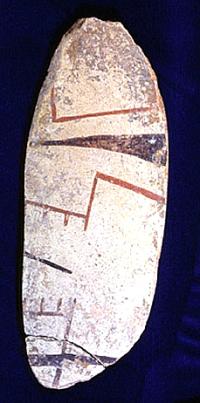
Rounded sherd used as a pottery smoothing
tool at Firecracker Pueblo. This sherd is from a polychrome
(multi-colored) vessel from the Casas Grandes area in
northern Chihuahua, Mexico. By studying the distribution
of such distinctive pottery types, archeologists are
able to trace the extensive trade networks connecting
the Jornada Mogollon with neighboring peoples.
|
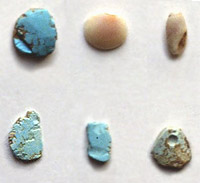
Turquoise pendants, marine shell
beads, pottery, and many other items were traded widely
among the Jornada Mogollon and groups in distant regions.
These items are from Firecracker pueblo.
|
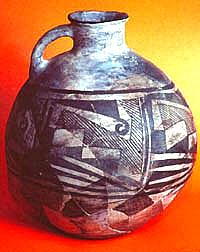
Chupadero Black-on-white jar, a popular
trade item from the Gran Quivera area in central New
Mexico. From Embree Pueblo on Rio Grande north of Las
Cruces.
|
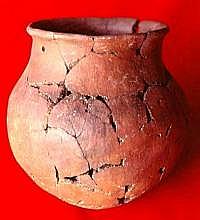
Red ware jar from small pueblo near
Firecracker Pueblo. Locally made and has four suspension
holes drilled below and evenly spaced around the rim.
Similar modification is seen on pottery made in the
Casas Grandes area.
|
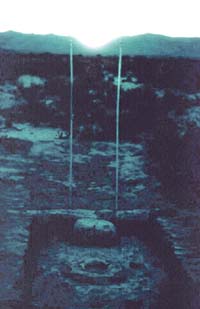
Observatory room at Hot Well Pueblo
at sunrise on the vernal equinox.
|
|
The western tip of Texas and adjacent areas
of southern New Mexico and northern Mexico have a distinctive
archeological tradition known as the Jornada Mogollon. The
"jornada" comes from the Jornado del Muerto—journey
of death—a reference to a desolate stretch of the Camino
Real (King's highway) used by the Spanish on their way north
from El Paso to Sante Fe. Just north of Las Cruces, the terrain
forced travelers to swing far to the east of the Rio Grande
through a waterless basin between mountain ranges. "Mogollon"
refers to the archeological remains left by the later prehistoric
peoples in much of southern New Mexico, east-central Arizona,
northern Chihuahua, and far western Texas.
The Mogollon tradition is one of the "big
three" cultures in the Southwest (the others are the
Anasazi and Hohokam) and is the largest in geographical extent
spanning some 400 miles east-west and as much as 500 miles
north-south. Various Mogollon "branches" have been
defined to describe the cultural variation across such an
immense area including the Jornada Mogollon, the branch farthest
to the east. Across the Mogollon region, many similar cultural
patterns can be traced, although the timing and expression
of these patterns varies from branch to branch.
Perhaps the most fundamental shared pattern—one
that is paralleled in the Hohokam and Anasazi areas—is
the shift through time from hunting and gathering to agriculture
and from highly mobile to increasingly sedentary lifeways.
Early Mogollon peoples, between roughly A.D. 400-800, lived
in small pithouse villages and hamlets. After A.D. 800 or
so, pithouse villages were built on an increasingly larger
and more elaborate scale as agriculture became more important.
By A.D. 1150, Mogollon peoples began building masonry and
adobe pueblos, similar to those of the Anasazi, with increasingly
concentrated populations relying heavily on agriculture. But
by A.D. 1400-1500, much of the Mogollon area was depopulated
and Mogollon culture ceased to exist as a distinctive archeological
expression. Most archeologists now believe that the Mogollon
and Anasazi cultures were both ancestral to the Pueblo peoples
first seen by Coronado in 1540.
The Jornada Mogollon area saw many of the same
cultural developments that were taking place elsewhere in
the Mogollon area as well as the Anasazi area to the north.
By about A.D. 400 (or earlier) pithouse villages were established
by peoples making distinctive El Paso Brownware ceramics.
They were experimenting with cultigens—corn, beans, and
squash—but still lived on mainly wild plants and animals.
Through time the villages became larger and more complex as
reliance on agriculture increased and more permanent settlement
was possible. Extensive trade networks were developed between
different areas of the Southwest including the more sophisticated
regional center of Paquimé (Casas Grandes) in northwestern
Chihuahua.
Around A.D. 1200, the first pueblos— rectangular,
multi-room living compounds made of coursed adobe brick—appear
in the Jornada area. Over the next 250 years, numerous pueblos
were established, some lasting for several generations, others
soon abandoned. Agriculture was now the mainstay of the economy
and an ingenious variety of farming techniques was employed
including dry land, runoff diversion, and in some cases, irrigation.
In the Hueco Bolson where Firecracker Pueblo is located, there
were few opportunities for anything but runoff diversion,
a method best suited for farming the alluvial fans at the
base of the mountains. But, because the area was very dry
and subject to drought, the small farming communities lived
a precarious existence. Several bad years in a row were probably
enough to force the people to move to a better location.
The Pueblo period, or El Paso phase (A.D. 1200-1450),
in the Jornada Mogollon saw a great deal of interaction with
other regions, especially the Casas Grandes culture to the
south in Mexico, but also southwest New Mexico and southeastern
Arizona, as well as the Anasazi area to the north. This is
most easily seen and documented in the pottery types and shell
ornaments. Trace-element studies have shown that certain types
of pottery were moved long distances. Types such as Mimbres
Black-on-white, Chupadero Black-on-white, Playas Red Incised,
and El Paso Polychrome were all widely distributed across
distances of 200 miles and more from their production centers.
As the name suggests, El Paso Polychrome was produced locally
in the Hueco Bolson, at Firecracker Pueblo and many other
sites.
Partial El Paso Polychrome vessels
from Firecracker. On the left is a jar and on the right
is a bowl.
By the late fifteenth century, virtually all
of the Jornada Mogollon pueblos had been abandoned, including
Firecracker, and the regional population dropped precipitously.
Archeologists debate the reasons why, but most likely it was
a combination of factors including overpopulation, an overly
specialized agricultural economy, and an unfavorable climatic
shift to drier conditions and less predictable rainfall. We
are not entirely sure what happened to the people. Some may
have stayed in the area in small bands and family groups and
shifted back to hunting and gathering. The Manso and Suma
peoples encountered in the El Paso vicinity by the early Spanish
could be descendants of Jornada Mogollon groups, but were
said to be hunters and gatherers who did not grow corn or
make pottery. Other Jornada Mogollon people probably moved
north into the Salinas area of central New Mexico and became
part of the pueblos at Gran Quivira and other localities visited
by the Spanish.
However it happened, most of the Jornada
Mogollon area was abandoned before the Spanish arrived. It
is not coincidence that the same thing occurred in other nearby
regions such as the Casas Grandes area in northern Mexico
and the Mimbres area in south-central New Mexico. This was
a time of tumultuous change all across the American Southwest
and Northern Mexico, one that archeologists are still trying
to understand.
|
|
Across the Mogollon region, many similar cultural
patterns can be traced, although the timing and expression
of these patterns varies …
|
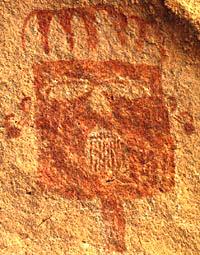
Pueblo period red mask pictograph
at Hueco Tanks.
Click images to enlarge
|
|
Most archeologists now believe that the Mogollon
and Anasazi cultures were both ancestral to the Pueblo
peoples first seen by Coronado in 1540.
|
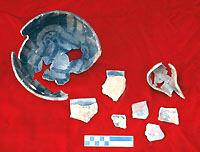
Partial El Paso Polychrome bowl and
a fragmentary ladle from Firecracker.
|
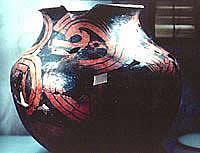
Large El Paso Polychrome jar with
plumed serpent design found at Paquíme (Casas
Grandes). The shiny luster has been added during conservation.
Photo by Vernon Brook.
|
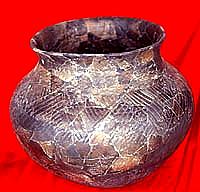
Playas Red Incised jar from Robledo
Mountain Pueblo near Las Cruces. Playas Red was one
of the most widely traded pottery types and is found
from southeastern Arizona to Trans-Pecos Texas and from
Truth or Consequences, New Mexico south to the Rio Conchos
in Mexico.
|
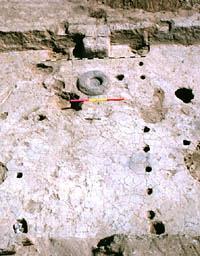
Unusual pueblo room at Hot Well Pueblo
thought to have been an observatory. Hot Well is located
near Hueco Tanks and is one of the largest pueblos in
the Hueco Bolson. Photo by Vernon Brook.
|
|